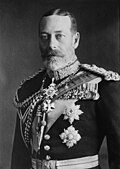History
Appointed by the monarch of the United Kingdom, the ceremonial head of the Royal Marines was the Colonel in Chief until the title changed to Captain General in 1948. [2] The first Captain General Royal Marines was King George VI. Following his death he was succeeded by Prince Philip, Duke of Edinburgh, consort to Queen Elizabeth II; Prince Philip is the longest serving Captain General to date. [3]
Following Prince Philip's retirement from royal duties in 2017, Prince Harry was appointed as Captain General. [4] As Captain General, Prince Harry was entitled to wear the rank insignia of a Field Marshal. [5] Despite this, Prince Harry, at least on some occasions, wore the rank insignia of a Colonel, [6] [7] which is traditionally worn by some colonels-in-chief in the British Army. [8]
King Charles III was announced as Captain General on 28 October 2022, on the 358th anniversary of the corps' founding by King Charles II in 1664. [9] Charles III separately holds the position of Head of the Armed Forces, which like some of his predecessors also makes him the Commander-in-Chief of the Royal Marines. [10]
This page is based on this
Wikipedia article Text is available under the
CC BY-SA 4.0 license; additional terms may apply.
Images, videos and audio are available under their respective licenses.







